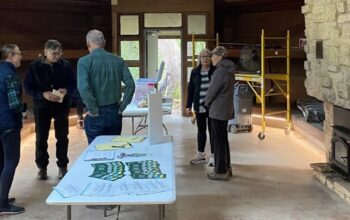School gardens have found a home in Madison. Over 30 local schools are incorporating garden-based education into the curriculum, and the rewards outweigh the challenges.
Ginny Hughes, education director for Community Groundworks, said gardens often begin with the vision of a passionate teacher, parent or community resident, but leadership changes and lack of funding, time and energy can lead to the downfall of an intended garden space.
“It’s always changing, and it always requires attention, so that work requires resources,” Hughes said. “I think that’s where we find a lot of lack in our Madison schools.”
That’s where the Wisconsin School Garden Network comes in.
The Wisconsin School Garden Network offers support for new and existing gardens at schools, early care and education centers, community centers and after-school sites through free workshops and technical support.
The organization, established in April 2016, and funded by the Wisconsin Partnership Program at the University of Wisconsin School of Medicine and Public Health, connects educators and school garden leaders to free resources, funding and a communication network to share ideas about improving children’s health and well-being through a garden-based education.
“We found that by bringing educators together, not only did it help for them to learn something new, for example, curricula that they could use, but also that opportunity to share resources and ideas with each other and share inspiration, which is really powerful,” said Nathan Larson, director of the Wisconsin School Garden Network
Madison-area Gardens Flourish
Glendale Elementary School on Madison’s east side started a school garden in 2009. It thrived for several years until the garden’s founders moved on to new projects in 2014.
Sara Milewski, a bilingual resource teacher at Glendale, took over the space. Without any gardening training, she attempted to keep the garden alive on her own.
It fell into disrepair, and the space was frequently vandalized.
Nancy Kieraldo, a former librarian at Glendale, volunteered to help with the garden following her retirement and after receiving her certification in master gardening.
When Kieraldo stepped in, the garden “had a very nice crop of perennial weeds,” she said.
Kieraldo started to get her hands dirty during the 2015 growing season. She finished the fall harvest with a vision.
To realize her vision, Kieraldo established a steering committee for the garden and applied for grants to build up the infrastructure of the space, including implementing straw bale gardening and vertical cages.
She created make-your-own-garden kits to guide the curriculum. The kits featured a recipe, and everything planted was an ingredient in that recipe.
Students planted salsa gardens last year. Pizza was on the menu this past growing season.
Students make the recipe with Kieraldo following the harvest and have a chance to try their creations.
“Very few students after they’ve grown it end up saying no,” Kieraldo says. “They all try it. And some of them even like it. And some of them even go back for seconds and thirds.”
At Glendale, sixty-eight percent of students received free or reduced-price lunches in 2015. Kieraldo said that some students are unaware of where their food comes from.
She recalled harvesting cherries with students last year.
“We walked right up to the cherry tree, and one of the young men said ‘are those real cherries?’” Kieraldo said. “They had never seen how food grows.”
Sue Bernhagen, a kindergarten teacher at Glendale and a member of the garden’s steering committee, remembered her students pointing out that basil growing in the garden were leaves, and they were surprised to find out they could try some.
“They were like, ‘wait, we can eat this?’” Bernhagen said.
A snacking garden allows students to try produce as they pass by. Students take home bags of produce after a harvest, and community members can volunteer in the garden and reap the rewards with fresh fruits and vegetables to take home and cook for their families.
Milewski and Kieraldo noted students love to work in the garden.
Kieraldo divides projects so every student is engaged and able to participate. Students enjoy looking for worms and bugs, and picking raspberries and eating them fresh on the spot.
Research suggests students who receive a garden-based education have stronger knowledge about nutrition, leading them to consume more fruits and vegetables.
Cultivating a garden improves students’ social skills, self-efficacy and self-understanding.
Milewski worked with a student facing behavior challenges one fall. She often took him out to the garden to seek a quiet space during challenging times of the school day.
The student began trying food from the garden and searching for critters among the plants.
Milewski said the experience helped the student learn to regulate his own behavior. He was working in the garden with classmates and showing them the space by the spring time.
Ongoing Challenges
The benefits of a garden-based education do not come without challenges. Teachers and volunteers overseeing school gardens oftentimes lack funding and basic gardening training.
The physical garden space itself can even be an obstacle.
School gardens begin with a vision, but leadership changes can leave the responsibility to teachers who see the benefits but lack the knowledge, time and resources required to maintain the infrastructure of a garden.
Like Milewski, not all teachers who oversee a school garden program are gardeners. Teachers face barriers in maintaining the space and developing a curriculum around a field they have little knowledge about.
“There is a lot – a lot – of background information in gardening that you need to know,” Kieraldo said.
But it’s not about being a gardener to Larson.
“It’s about using that space,” Larson said. “It’s a community model.”
The Wisconsin School Garden Network provides that community for less-knowledgeable educators. Free workshops and technical assistance help educators build new gardens or rebuild an existing space.
Backing for a school garden can be lacking, too.
“It can be difficult work, coordinating a school garden program,” Larson said. “Often, you’re working in isolation, or there’s not all the support you could use.”
The Wisconsin School Garden Network works with school administrations to make the case for establishing a school garden. The organization also interacts with local and state governments to enact policies that support school gardens.
Getting students into the garden can be another challenge. An unfamiliarity with teaching outdoors inhibits teachers attempting to develop garden-friendly lesson plans.
The Wisconsin School Garden Network provides a communication network for educators to exchange ideas and inspiration for implementing a garden-based curriculum.
Bernhagen integrates the garden into her curriculum during spring planting by teaching students about seeds and what they need to grow as part of science lessons.
“We do things outside that aren’t specifically tied to the garden but they’re in the garden space,” Bernhagen said.
Bernhagen held a writer’s celebration outside where her students shared their stories on a stage near the garden. She takes her class outside for reading and sometimes just to sit near the garden.
“I think it’s really just using that space more as an outside learning space,” Bernhagen said. “We’ve got a lot of kids with a lot of energy, and I think being in nature is calming. We talk about doing our belly breaths and our rainbow breaths and just being outside.”
Larson said another part of the Network’s mission is to ensure that anyone who wants to spend time in a school garden has access to one.
One of the organization’s primary goals is to provide an equal, diverse and inclusive network where educators, parents and students from all socio-economic backgrounds can find and utilize resources to address their community’s needs.
In low income schools and communities, the focus is on technical assistance, free training, funding and curriculum resources and general support.
Budgeting is another issue for school garden leaders. Kieraldo estimates the 2017 garden season at Glendale cost between $600 and $900. The costs covered gardening materials, seeds, plants and a small stipend for when Kieraldo works directly with students.
The majority of Glendale’s funding comes from the Madison School Community Recreation Program, since Kieraldo provides direct services for the program’s afterschool and summer programs.
Two grants totaling $800 further allowed Kieraldo to improve the infrastructure of the garden last year.
Kieraldo says it would be difficult to provide the current garden and nutritional programming without a source of funding. Although she has the space and tools, the budget covers the consumable products grown in the garden.
The Wisconsin School Garden Network uses its website and social media to connect educators to necessary funding resources, regional experts and free workshops. Schools can put their gardens on a map, which acts as visual representation of the school garden movement.
“The network is about connecting people with each other so that one garden can help another garden,” Larson said. “We hope through this work and the work of our partners that eventually we’ll see a garden teacher in every school.”





